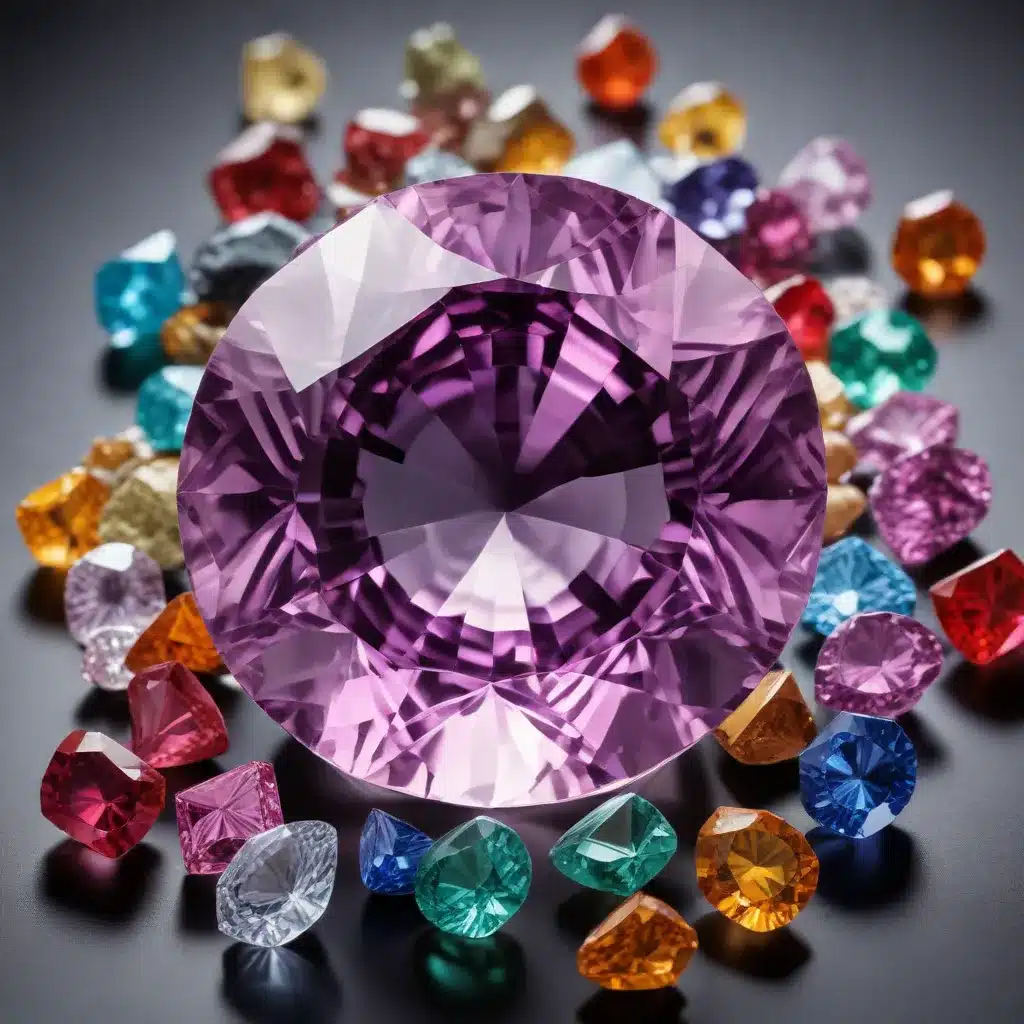
The world of gemstones is a captivating realm where the interplay of light and matter creates breathtaking optical phenomena. From the mesmerizing fire of a diamond to the alluring color shifts in a pleochroic gem, the science behind these precious stones is a testament to nature’s exquisite design. As a gem and jewelry expert at Shelby Gem Factory, I’m thrilled to delve into the optical marvels that make gemstones such coveted and cherished objects.
Fundamental Optical Properties of Gemstones
At the heart of a gemstone’s optical allure lies a complex interplay of light-based phenomena, governed by the stone’s unique refractive index, dispersion, and birefringence. The refractive index, which measures how much the speed of light slows down when passing through a material, determines a gem’s brilliance and fire. Diamonds, for instance, have a remarkably high refractive index of 2.42, allowing them to bend and scatter light in mesmerizing ways.
Dispersion, the separation of white light into its component colors, is another key optical property that gives rise to the dazzling rainbow-like effects seen in many gems. Diamonds, with their exceptionally high dispersion, exhibit the iconic “fire” that has captivated jewelry enthusiasts for centuries. In contrast, materials like cubic zirconia (CZ) and moissanite, while visually similar, possess lower dispersion, resulting in a less pronounced fire.
Birefringence, the ability of a gem to split a single ray of light into two separate rays, can also contribute to the optical allure of certain stones. This phenomenon, known as pleochroism, manifests as shifting colors when the gem is viewed from different angles, adding an extra layer of visual intrigue. Emeralds, for instance, often exhibit a captivating play of green hues due to their pronounced birefringence.
Optical Characteristics of Common Gemstones
Diamond: The Brilliant Gem
At the pinnacle of gemstone optics, the diamond reigns supreme. Its unparalleled refractive index and dispersion properties allow it to bend and scatter light in a way that creates the illusion of an internal fire. The precise cutting and polishing of a diamond’s facets are crucial in maximizing its optical performance, with the brilliant and round brilliant cuts being the most popular for their exceptional brilliance and scintillation.
Emerald: The Verdant Treasure
Emeralds, with their rich green hues, captivate the eye through a different set of optical principles. The birefringence inherent in their crystal structure results in a distinct pleochroic effect, where the gem appears to shift between various shades of green when viewed from different angles. This optical phenomenon, combined with the stone’s transparency and clarity, contributes to the mesmerizing allure of the emerald.
Ruby: The Fiery Crimson Gem
The ruby, a member of the corundum family, owes its vibrant red color to the presence of chromium impurities within its crystal structure. This chromium also lends the ruby a distinct fluorescence property, which can be enhanced through careful cutting and polishing to create a mesmerizing inner glow. The ruby’s high refractive index and hardness (9 on the Mohs scale) make it a durable and optically striking gemstone.
Advanced Optical Phenomena in Gemstones
Beyond the basic optical properties, some gemstones exhibit remarkable and captivating optical effects that truly set them apart.
Asterism: The Star-Like Effect
Certain gems, such as star sapphires and star rubies, can display a striking star-like pattern when exposed to light. This phenomenon, known as asterism, is caused by the presence of tiny needle-like inclusions within the gem’s crystal structure, which act as reflective planes and refract light to create the six-rayed star pattern.
Chatoyancy: The Mesmerizing Cat’s Eye
The cat’s eye effect, or chatoyancy, is another captivating optical characteristic found in some gemstones. This happens when the gem’s internal structure contains parallel, fibrous inclusions that reflect light, creating a single, shimmering band of light that appears to move across the surface of the stone as it is rotated.
Iridescence: The Rainbow-Hued Brilliance
Some gems, like opals and labradorite, exhibit a mesmerizing iridescent quality, where the stone appears to shimmer with a rainbow of colors. This optical effect is caused by the interference of light waves within the gem’s internal structure, creating a stunning display of hues that seems to dance across the surface.
Gemstone Cutting and Its Optical Impact
The art of gem cutting and polishing plays a pivotal role in unleashing the full optical potential of a gemstone. By carefully shaping the stone’s facets and proportions, skilled artisans can harness the gem’s inherent optical properties to maximize its brilliance, fire, and overall visual appeal.
Traditional faceting techniques, such as the brilliant, step, and mixed cuts, have long been employed to enhance the optical performance of various gemstones. However, the modern era has also given rise to innovative cutting styles that push the boundaries of gemstone optics. From the mesmerizing fantasy cuts that mimic natural forms to the precisely engineered precision cuts designed to optimize specific optical effects, the world of gemstone cutting is a constantly evolving canvas of artistic expression and scientific exploration.
Ultimately, the interplay of a gemstone’s natural optical properties and the skill of its cutting and polishing is what transforms a raw, unassuming material into a mesmerizing, light-refracting work of art. Whether it’s the fire of a diamond, the color play of an opal, or the captivating asterism of a star sapphire, the optical marvels of precious stones continue to captivate and inspire jewelry enthusiasts, designers, and scientists alike.
To learn more about the fascinating world of gemstone optics and how Shelby Gem Factory crafts these optical wonders, visit https://www.shelbygemfactory.com. Our team of experts is dedicated to revealing the hidden beauty and scientific complexities that lie within each precious stone.

